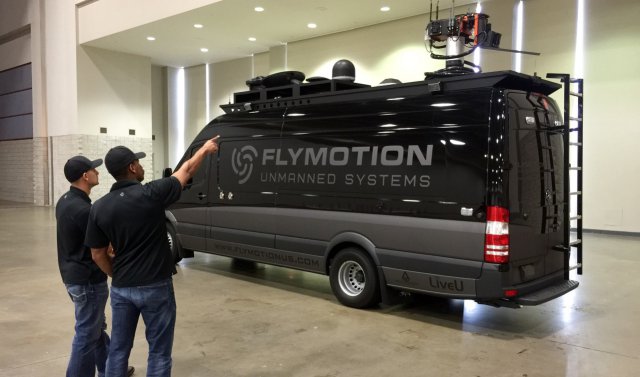A little more than a year ago, the team at FlyMotion Unmanned Systems decided it was time to develop a command and control vehicle for unmanned aerial systems. They saw a need in the UAS market for this type of product, which they released in the form of the rapidly deployable TRIDENT in late 2015.
The vehicle, which FlyMotion President and Co-Founder Ryan English describes as first of its kind, enables rapid UAS deploy and fly functionality. This makes it possible for operators to pilot UAS from dedicated flight stations inside the vehicle as well as view any data collected. Ultimately, it serves as the central hub to process and disseminate data collected from UAS.
“The biggest benefit is the mobile command and control TRIDENT offers,” English said. “No longer do you have to send a guy to pull the SD card out of the UAS to get all the data. Everything comes back to TRIDENT. All the data can be managed.”
The compact vehicle, which is a Mercedes-Benz Sprinter, has the ability to travel to a variety of places, both small and large, where UAS might be needed. Government agency vehicles are typically too big to deploy in a variety of situations, a challenge TRIDENT helps overcome, English said. It can also be used for media broadcast, emergency operations, utility inspection, in the oil and gas industry and during natural disasters.
“We really put a lot of focus on making sure we developed a diverse platform for many industries rather than just targeting one,” English said. “We feel UAS are the future for many different industries, and are making operations more cost effective in many of those industries overnight.”
TRIDENT is also rapidly deployable, English said, meaning users can have the vehicle ready to go within a few minutes. The team also wanted to create something that was filled with sophisticated technology and equipment that not only can be used on the mobile command unit side, but also on the unmanned side.
 The vehicle is customizable to each client’s needs, but common features include multiple flight stations to operate UAS from inside the vehicle, two 50 inch monitors with split screens for multiple feeds, bonded cellular and satellite hybrid technology for true live broadcast anywhere in the world. It also has an onboard recording system, a high-definition camera that monitors the scene around the vehicle, a smartboard to help develop various operational plans and satellite to monitor both local and national news for incident management.
The vehicle is customizable to each client’s needs, but common features include multiple flight stations to operate UAS from inside the vehicle, two 50 inch monitors with split screens for multiple feeds, bonded cellular and satellite hybrid technology for true live broadcast anywhere in the world. It also has an onboard recording system, a high-definition camera that monitors the scene around the vehicle, a smartboard to help develop various operational plans and satellite to monitor both local and national news for incident management.
Its deployable 48’ mast serves as the main communication tool for flight control and broadcast systems. The mast transmits and receives sensitive flight control data and broadcast signals. TRIDENT also features a self-contained, integrated generator to power flight systems. The onboard compartment uses special materials designed to reduce vibration and decrease generator noise.
It took the team at FlyMotion about a year to develop TRIDENT, English said, and they went through many different design and engineering changes over that time. They wanted to make sure they provided a product with the capabilities the UAS industry needed, and so far they’ve received a lot of positive feedback about TRIDENT and what it can do for UAS.
In the next few weeks, FlyMotion is set to launch a smaller vehicle platform, with other products expected to be released throughout the year.
“We have some definite game changing products coming out in the next several months,” English said. “We’re committed to developing products and solutions that are needed in the industry and our big focus is on innovation. That’s what we’re known for. It’s a constant think tank with us to make sure we’re staying on the cutting edge.”
Sources: Website; Inside Unmanned Systems

